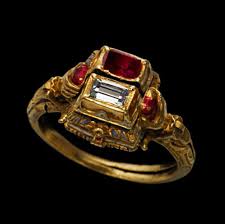
Picture from the Met Museum
This ‘gimmel’ ring was made in Germany in 1631. This type of ring has multiple circlets that fit like puzzle pieces. The word ‘gimmel’ comes from the Latin word gemelli, meaning twins, and often signified two connected eternity rings denoting a couple’s permanent joining in marriage. This type of ring was popular during the Renaissance, but the idea of such rings continued well into the 17th century.
This example has two rings, beautifully crafted, that when separated reveal a hidden secret cavity within each one. In one side is housed an enamelled baby, curled into a foetal position, and the other cavity forms a coffin for a skeleton. The rings are designed to be like snakes, and the words engraved on the inside read, ‘Whom God has joined together, let no man tear asunder.’
This particular type of ring, a Memento Mori which symbolises both the beginning and the end of life, is very rare. Obviously this took a lot of thought to design and make, and it is made from very expensive materials: gold, diamonds and rubies, so the couple were probably wealthy and from the upper portion of society. Despite this, they were also concerned with their inner life, as a Memento Mori, literally ‘remember that you have to die’ in Latin, is an expression designed to puncture delusions of grandeur.
The expression derives from Ancient Rome. When a general returned victorious from battle, and during his parade, in which he would be lauded and complimented, a slave would follow behind, saying, Respice post te. Hominem te memento (approx. translation – Look to your end and remember you’re only a man.) Since then, these reminders of mortality have been one of the ascetic disciplines used to perfect the character, encouraging detachment and turning the attention towards the levelling at death.

The closed ring
Sources:
In this series of Curio-stories, you might also like: An Apostle Spoon Shoes from the Mary Rose

Fascinating! I’m reminded of the fact that John Donne slept beneath a portrait of himself in his shroud for similar reasons.
Enjoyed this. I haven’t seen rings these before. Thank you.
Thanks for stopping by, Nancy.
Sorry it ate your previous comment. My top tip is just to write about something that seriously interests you. Blogging takes time, and it’s much nicer if you enjoy what you are writing. I tend to pick things that fascinate me, and hope they will interest others too.
Never seen one of these before. Thank you.
Aren’t they interesting! In the 1970’s there was a fashion for ‘puzzle rings’ which interlocked, but none were quite as elaborate as these.